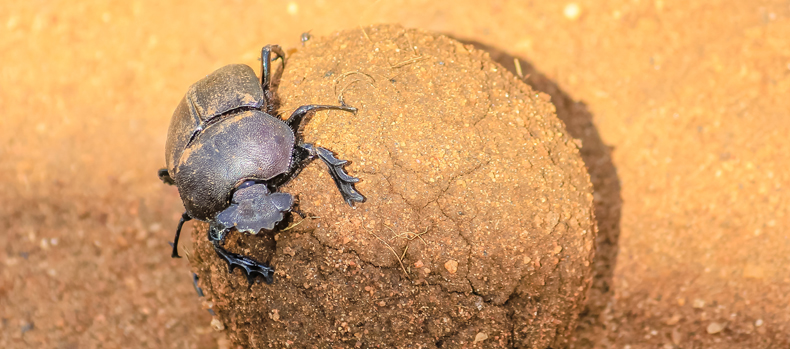The world’s strongest insect – the hidden paddock workers

The dung beetle! You wouldn’t believe how strong these little paddock workers are and the truly remarkable benefits above and below the ground. These little critters have great effects on your soil, pasture, global warming, reducing the population of bush fly and improving cattle grazing and nutrient recycling.
2 common types of dung beetles in Australia
Best known as ‘Ball rollers’ and ‘tunnellers’ and as the name describes, the ball rollers roll the dung into a ball and then bury the dung by digging underneath the ball. Tunnellers will dig tunnels and fill the tunnels with dung. Tunnelling dung beetles are brilliant at aerating the soil and making room underground for plants to grow their roots deeper, especially when soil types are hard and/or somewhat compacted. By moving the dung underground, the dung beetles are essentially moving nitrogen and phosphorus from the dung into the ground to be better utilised by the plants, thus potentially reducing the need for fertilisers.
7 interesting facts about dung beetles:
- A dung beetle can bury dung 250 times heavier than itself in just one night.
- Dung beetles can roll up to 10 times their weight.
- Male beetles are extremely strong little buggers and can pull 1,141 times their own body weight: the equivalent of an average person pulling six double-decker buses full of people.
- After a dung beetle rolls the dung it follows a straight line despite all obstacles.
- They have been proven to reduce the population of bush fly in paddocks by up to 99%.
- It was found in a South African experiment that dung beetles returned over 90% of the faecal nitrogen excreted by each steer in the experiment during a summer grazing season.
- Several species of the dung beetle enjoyed a sacred status among the ancient Egyptians. Carvings and drawings of the sacred scarab are seen right through Egyptian history.
Global warming warriors?
Possibly one of the most interesting, and environmentally friendly things these little dung beetle superstars do, is to assist in the reduction of greenhouses gases going into the atmosphere. According to the UN, livestock (such as sheep, cows, goats and buffaloes) emit more greenhouse gas worldwide than the transportation industry as a whole. These livestock apparently emit over a third of the world’s methane emissions via their pats or dung. When dung beetles tunnel through the dung or roll it up, they are aerating it. Thus, altering the conditions so that less methane is produced by the dung over time. Studies have found that this can equate to a reduction in methane gas released into the atmosphere by up to a staggering 40%!
Ever watched a dung beetle at work?
Our QLD Regional Manager, Hannah Kennedy, was recently visiting clients using Beachport Liquid Minerals in Southern QLD where she saw dung beetle activity in their paddocks.
“It’s great to see dung beetles at work in our clients’ paddocks. By providing liquid minerals that are beneficial to livestock – and not harmful to dung beetles – we are creating an environment whereby the producer can ensure their dung beetle colonies can continue to do their amazing work.”
For more information on dung beetles in Australia, see these websites:
The Dung Beetle Expert
Dung Beetles Australia
Dung Beetle Solutions Australia
To find out more about greenhouse gases and the positive impact dung beetles are having, read this story from The National Geographic.
Written by Tammy Flier
